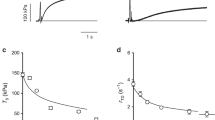Abstract
During potassium depletion in rats, the skeletal muscles lose potassium and gain sodium, whereas the Na-K contents of the liver1, brain, cerebrospinal fluid2,3, erythrocytes and heart4 remain virtually constant for several weeks. Since the selective loss of potassium ions from the muscles may result from inhibition of the active Na-K transport5, it is of interest to determine whether potassium depletion is associated with a reduced capacity for Na-K pumping. This study explores this possibility with measurements of 3H-ouabain binding and 42K uptake in soleus and extensor digitorum longus muscles obtained from rats or mice during potassium deficiency induced either by K-free diet, a diuretic or a potassium-binding resin. Potassium depletion leads to a pronounced (up to 78%) and reversible decrease in the total number of 3H-ouabain binding sites and a reduced capacity for Na-K pump-mediated 42K uptake. This decrease in the number of functional Na-K pumps may be of importance for the selective loss of potassium from skeletal muscle and its maintenance during potassium depletion. Furthermore, it favours the redistribution of digitalis glycosides from the periphery to the heart and provides an explanation for the increased digitalis toxicity seen in patients suffering from chronic potassium depletion.
This is a preview of subscription content, access via your institution
Access options
Subscribe to this journal
Receive 51 print issues and online access
$199.00 per year
only $3.90 per issue
Buy this article
- Purchase on Springer Link
- Instant access to full article PDF
Prices may be subject to local taxes which are calculated during checkout
Similar content being viewed by others

References
Heppel, L. A. Am. J. Physiol. 127, 385–392 (1939).
Bradbury, M. W. B. & Kleeman, C. R. Am. J. Physiol. 213, 519–528 (1967).
Nattie, E. E. Life Sci. 21, 1851–1855 (1977).
Erdmann, E. & Krawietz, W. Acta biol. med. germ. 36, 879–883 (1977).
Akaike, N. Brain Res. 178, 175–178 (1979).
Kohn, P. G. & Clausen, T. Biochim. biophys. Acta 225, 277–290 (1971).
Chinet, A., Clausen, T. & Girardier, L. J. Physiol., Lond. 265, 43–61 (1977).
Crettaz, M., Prentki, M., Zaninetti, D. & Jeanrenaud, B. Biochem. J. 186, 525–534 (1980).
Clausen, T. & Hansen, O. Biochim. biophys. Acta 345, 387–404 (1974).
Clausen, T. & Hansen, O. J. Physiol., Lond. 270, 415–430 (1977).
Clausen, T., Sellin, L. C. & Thesleff, S. Acta physiol. scand. 111, 373–375 (1981).
Clausen, T. & Kohn, P. G. J. Physiol., Lond. 265, 19–42 (1977).
Chan, P. C. & Sanslone, W. R. Archs Biochem. Biophys. 134, 48–52 (1969).
Boardman, L. J., Lamb, J. F. & McCall, D. J. Physiol., Lond. 225, 619–635 (1972).
Pollack, L. R., Tate, E. H. & Cook, J. S. J. cell. Physiol. 106, 85–97 (1981).
Friedman, M. & Bine, R. Jr Am. J. med. Sci. 214, 633–638 (1947).
Kleiger, R. E., Seta, K., Vitale, J. J. & Lown, B. Am. J. Cardiol. 17, 520–527 (1966).
Author information
Authors and Affiliations
Rights and permissions
About this article
Cite this article
Nørgaard, A., Kjeldsen, K. & Clausen, T. Potassium depletion decreases the number of 3H-ouabain binding sites and the active Na-K transport in skeletal muscle. Nature 293, 739–741 (1981). https://doi.org/10.1038/293739a0
Received:
Accepted:
Issue Date:
DOI: https://doi.org/10.1038/293739a0
This article is cited by
-
Changes in the expression of Na+/K+-ATPase isoenzymes in the left ventricle of diabetic rat hearts: effect of insulin treatment
Diabetologia (1997)
-
Relation between extracellular [K+], membrane potential and contraction in rat soleus muscle: modulation by the Na+-K+ pump
Pflügers Archiv European Journal of Physiology (1995)
-
Changes in Na+, K+-adenosinetriphosphatase, citrate synthase and K+ in sheep skeletal muscle during immobilization and remobilization
European Journal of Applied Physiology and Occupational Physiology (1995)
-
Tissue-specific modulation of Na, K-ATPase α-subunit gene expression in uremic rats
Kidney International (1994)
-
Regulation of the Na, K-pump in skeletal muscle
Kidney International (1989)
Comments
By submitting a comment you agree to abide by our Terms and Community Guidelines. If you find something abusive or that does not comply with our terms or guidelines please flag it as inappropriate.


